

Taken somewhere in the middle east.
Source: possibly USAF photo, but not sure
On 13 September, 1997 this aircraft was lost in a mid-air collision with a German Air Force aircraft off the west coast of Africa. Arlington National Cemetary has information about the ceremony that took place there for this crew on April 2nd, 1998, and to a special page about one of the pilots, Gregory M Cindrich
The C-141 had flown from Ascension Island to deliver UN humanitarian supplies to
Windhoek Namibia, in southwestern Africa. They were scheduled to return that
evening.
The German Air Force Tu-154 had departed Cologne for Capetown South Africa, with
stops in Niamey Niger and Windhoek Namibia, The Tu-154 crew had filed a flight
plan, in Niamey, requesting an initial cruise altitude of FL350 with a subsequent
enroute climb to FL390. They received a small re-route while transiting the
airspace of Gabon. The crew never requested the enroute climb and remained at
FL350 for the duration of the flight. Passing western Africa, the course of the
Tu-154 changed from westerly to easterly, requiring a change in flight level to
comply with international air traffic control procedures. Neither the Tu-154
aircrew nor African air traffic control agencies requested a change in altitude.
The C-141 crew departed on the return leg for Ascension Island at 1611 local time
(1411 GMT). Shortly after level off; at FL350, the C-141 collided with the
Tu-154, approximately 80 NM off the coast of Namibia. Cockpit voice recordings,
from the Tu-154, indicated that someone in the German airplane spotted the
Starlifter just moments before the collision, but not in time to maneuver away.
The Tu-154 struck the C-141 in the lower fuselage.
A French Air Force aircraft, in the vicinity, heard a single "mayday" distress
call. A US reconnaissance satellite reported a bright flash at position 18.8°
South, 11.3° East at 1510 GMT, approximately one hour after the C-141
departed.
At 1600 GMT (2 hours after the scheduled takeoff), when they did not receive a
departure message for the C-141, ATC personnel at Ascension attempted to verify
the aircraft's departure. For the next 15 hours they made 50 phone calls
attempting to contact Namibian authorities. At 1055 GMT, they finally notified
AMC TACC that the aircraft was overdue. AMC declared the aircraft missing at 1100
GMT, nearly 20 hours after the collision.
The Namibian Air Traffic Control Agency reported that they were controlling the
C-141. They also claimed that they had not received a flight plan for the German
aircraft. They were unaware that it was in their airspace. The German aircraft
had just entered the Namibian FIR but had not yet made radio contact with the
Namibian ATC at the time of the collision. Investigation revealed that the
Aeronautical Fixed Telecommunications Network (AFTN) was inoperative. Luanda
(Angola) ATC had not contacted Windhoek, as required by ICAO procedures.
The South Africa Air Line Pilots Association had labeled the Angolan airspace as
"critically deficient". SAALPA had recorded 77 near-midair collisions over
Africa, in 1996.
Reports indicate that at the time of the mishap weather conditions were VMC. The
sun was low in the northwestern horizon (within 30 degrees of the horizon) and,
within 30 degrees of the C-141 flight path, making visual clearing for traffic
difficult. Local sunset occurred approximately one hour after the Starlifter's
departure from Windhoek. Neither the C-141 nor the TU-154 was equipped with TCAS
(Traffic Collision Alert System)
This information was provided by Paul Hansen
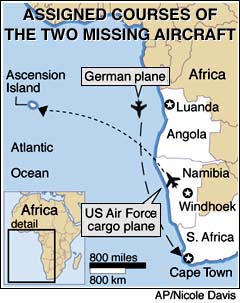
C-141 ACCIDENT LAID TO GERMAN AIRCRAFT
A USAF investigating board blamed a German aircraft flying at the wrong altitude
for the Sept. 13 crash of an Air Force C-141 in the south Atlantic. The accident
claimed the lives of nine on the C-141. Another 24 aboard the German aircraft, a
Tu-154, also perished.
The Air Force on March 31 released the accident investigation report detailing
the circumstances of the midair collision of the two aircraft off the coast of
Namibia, in southwest Africa. The board, headed by Col. William H.C. Schell Jr.,
375th Airlift Wing vice commander, Scott AFB, Ill., said the Tu-154 was flying at
the wrong cruise altitude. The board further learned that the German aircraft's
planned and actual flight altitudes violated the rules of the International Civil
Aviation Organization.
The C-141 had departed Namibia for Ascension Island in the Atlantic after
delivering US Army personnel and mine-clearing equipment to Windhoek Field,
Namibia.
The above report came from the AFA web site.
The following reports are from CNN. I am posting them here in case these stories on their site drop off web.
GERMAN, U.S. AIRCRAFT CRASH OFF AFRICAN COAST
David A. Fulghum/Washington and John D. Morrocco/London
"New Standard/ 9/16/97"
Specially equipped U.S. and South African Air Force aircraft have gathered in
Namibia to bring their electronic intercept, infrared sensor and all-weather
flight capabilities to bear in an often zero-visibility search for debris and
bodies from the midair collision of two transport aircraft.
A German Tu-154 with 24 on board, headed south to Capetown, South Africa, via
Windhoek, Namibia, and a U.S. Air Mobility Command C-141 with nine crewmembers,
flying northwest to Ascension Island from Windhoek, collided on Sept. 13 about 80
naut. mi. off the coast of Namibia.
Neither aircraft was equipped with a traffic alert and collision avoidance
system. U.S. Air Mobility Command has requested TCAS for all C-141s that will be
flying for five years or more. However, the program is unfunded, a USAF official
said.
The tu-154 was leaving an area that is considered by pilots organizations as
"critically deficient airspace" in terms of air traffic control. Both aircraft
were at about 35,000 ft.
A U.S. Space Command official said an infrared early warning satellite recorded a
flash or "IR event" at 11:10 a.m. EDT (5:10 p.m. local time) in the area of the
crash. A Namibian fisheries patrol boat and two trawlers pulled identifiable
parts of both aircraft and the body of a Luftwaffe flight attendant from the same
debris field. A French frigate arrived Sept. 17 to take on-scene command of the
surface search. Investigators were dispatched to the frigate to examine wreckage.
The Tu-154 was one of two in the Luftwaffe's inventory. Formerly the personal
aircraft of the East German president, it had been modernized and was fitted with
special surveillance equipment for the Open Skies treaty verification program.
The aircraft made a refueling stop at Niamey, Niger, and departed for another
stop at Windhoek. Luftwaffe officials said the crew filed a flight plan, and one
of the flight plan's recipients was to have been Windhoek. Speculation by the
Luftwaffe is that there was a communications problem between Niamey and Windhoek.
The aircraft's last direct contact was with ground controllers at Accra, Ghana,
at about 4 p.m. (German time).
The C-141, from the 305th Air Mobility Wing at McGuire AFB, N.J., last
communicated with the tower at Windhoek soon after a 4:11 p.m. (local time)
takeoff. The aircraft earlier had picked up Army personnel and equipment from
Pope AFB, N.C., delivered them at Windhoek, and was flying empty to Ascension
Island, an AMC official said.
Search and recovery efforts were hampered by fog, low ceilings and daily periods
of zero visibility. One of the SAAF's signals intelligence-equipped Boeing 707s,
two USAF MC-130 special operations aircraft designed for bad weather and night
operations, and two infrared-equipped P-3Cs of Patrol Sqdn. 45 were sent to
Windhoek, where operations were coordinated. They joined two German Atlantique
patrol aircraft. The air base is about 370 naut. mi. southeast of the search
area.
The search area was originally 20 X 20 naut. mi., South African officials said. A
new joint task force commander, USAF Brig. Gen. John Brooks, expanded the search
area to 30 X 30 naut. mi. on Sept. 18. Initially, thick fog covered the area from
3 a.m. until about 11 a.m. daily, leaving only about 712 hr. for visual search.
Cloud ceilings of as little as 250 ft. also limited observations. Therefore, the
U.S. and SAAF aircraft with sophisticated sensors were needed to continue the
search during hours of darkness and poor visibility. Infrared and radar
observations made at night were used to plan the next day's operations.
Tower operators at Windhoek told Aviation Week & Space Technology that the ramp
was now full of aircraft. South African Air Force planners said that beginning
the night of Sept. 17, they would stagger three aircraft--a P-3, an MC-130 and an
Atlantique--to patrol during the hours of darkness for infrared or electronic
signals. The SAAF 707 sigint aircraft had earlier in the week picked up what
could have been an automatic rescue beacon signal, but it was so faint that it
might also have been noise on the carrier wave, said Lt. Col. Eddie Brown, a SAAF
official at Windhoek. The area from which the possible signal emanated was to be
searched Sept. 18, he said.
Beginning at 7:30 a.m. on Sept. 18, an expanded visual search was to be conducted
with five other aircraft (a P-3, two Atlantiques and two C-130s). Ceilings were
expected to lift to about 1,000 ft. with clear weather possible late last week.
A representative of South Africa's air line pilots association (ALPASA) said that
members had feared such a crash. Angola, in particular, "has been unable to
upgrade and maintain its aviation infrastructure to keep pace with the increasing
volumes of air traffic flying across Africa," said ALPASA General Manager Cathy
Bill. "Communication between controllers and pilots is often difficult in the
Angola region, and it is possible that the two aircraft were not informed of
their close proximity." Bill said that pilots familiar with the region use
periodic aircraft-to-aircraft broadcasts to alert other traffic in their vicinity
of their presence and thereby avoid collisions.
This informal system is necessary because the International Civil Aviation
Organization (ICAO) can't force countries to comply with its standards and
practices. Bill and other pilots want ICAO to demand a uniform level of safety
throughout the world and to ensure overflight fees are used to provide safe and
adequate aeronautical services.
Some areas of africa have shown dramatic improvements recently, Bill said. "This,
however, appears to be dependent on who is on duty at the control center,
indicating that training is an area to be concentrated on," Bill said.
The were 17 fatal crashes in Africa in 1996. One caused 350 fatalities on the
ground. In another, an ADC Boeing 727 pilot maneuvered to evade another aircraft,
lost control and crashed, killing all 143 on board. Also, there were 77 near
midair collisions, according to an airline survey.
Source: As far as I know this info comes from the web site of Aviation Week and
Space Technology.
SEARCH FINDS AIRPLANE SEATS, PAPERS BUT NO SURVIVORS
By Tom Cohen, Associated Press writer
WINDHOEK, Namibia -- Searchers found airplane seats and a few papers yesterday,
but no bodies or survivors of the apparent collision between a U.S. military
transport and a German plane believed to have been flying in the same air route.
Air corridors often are shared, although planes traveling in opposite directions
are supposed to fly at different altitudes. Namibian officials said the probable
collision site was off their radar and they didn't know the German plane was
coming because they had not received a flight plan.
The Atlantic is 3,000 feet deep in the area of Namibia's Skeleton Coast where the
U.S. C-141 Starlifter and the German air force plane apparently collided and
crashed Saturday, and some officials doubted much wreckage ever would be found.
Nine Americans and 24 Germans were missing.
Military officials from Germany, the United States and South Africa --which is
responsible for sea rescue operations in the area -- converged on Windhoek to
coordinate the search. They also want to determine why it took 24 hours before
rescue officials were told the planes were missing.
"We are about to hire some divers," German air force Maj. Gen. Gerhard Buck said
in Windhoek, the capital of Namibia, which is northwest of South Africa on the
continent's south Atlantic coast.
Searchers found seats from the German plane and papers in German in two areas of
the sea yesterday near where the planes may have collided, about 115 miles west
of Cape Fria on the Namibian coast.
American officials said they could not say why it took so long to initiate a
search or what steps were taken when the U.S. plane did not arrive at Ascension
Island from Namibia as scheduled.
"I cannot reconstruct that for you. We simply do not have that information. I'm
not sure what the time line would be, but they would obviously inform people in
the United States," said U.S. Army Col. Michael Mensch.
The German plane vanished en route from Germany to Cape Town, South Africa, and
Namibian officials said they never received its flight plan.
"No departure signal, no flight plan. That's why we were not aware that the
airplane was coming," said Jochen Sell, Namibia's chief air traffic officer.
He told reporters such critical procedures are often absent in Africa.
"It is normal in Africa," Sell said. "We have a big problem, a major problem."
Buck said a flight plan for the German plane had been filed before takeoff from
Germany. But Sell said it was never passed on, as required, by controllers in the
central African nation of Niger.
A French aircraft flying over the apparent crash site Sunday night picked up a
faint distress signal which may have come from an automatic emergency beacon.
U.S. Air Force monitors in the European command also picked up the distress
signal at about the same time, South African officials said.
There were 12 German marines, two of their spouses and a crew of 10 aboard the
German aircraft.
McGuire Air Force Base identified those on the American plane as Capt. Peter C.
Vallejo, the aircraft commander; Capt. Gregory M. Cindrich, pilot; Capt. Jason S.
Ramsey, pilot; Staff Sgt. Robert K. Evans, flight engineer; Staff Sgt. Scott N.
Roberts, flight engineer; Staff Sgt. Stacy D. Bryant, loadmaster; Senior Airman
Gary Bucknam, flight engineer; Senior Airman Frankie L. Walker, crew chief; and
Airman Justin R. Drager, loadmaster. None of their hometowns were released.
PILOT ERROR MAY HAVE CAUSED NAMIBIA CRASH
Remains found from collision of German, U.S. planes
December 12, 1997
Web posted at: 8:50 p.m. EST (0150 GMT)
CNN: From Military Affairs Correspondent Jaime McIntyre
WASHINGTON (CNN) -- A collision in September between German and American military
aircraft off the coast of Namibia was likely caused by errors by the German crew
and poor air traffic control in the area, CNN has learned.
The mid-air collision between the German Tupolev-154 and the U.S. C-141 claimed
24 German and nine American lives. There were no survivors. On Thursday, salvage
crews located the first human remains, trapped in the wreckage of the German
plane under 3,000 feet of water.
Monica Cindrich, the wife of the pilot of the C-141, Capt. Greg Cindrich, says
Air Force officials have told her that the German plane was at the wrong altitude
and didn't stick to its flight plan.
Sources also tell CNN that faulty air traffic control operations in Namibia and
Angola contributed to the crash.
When they collided, the German plane was headed from Germany to South Africa. The
U.S. plane had left Namibia for Ascension Island in the South Atlantic.
But Mrs. Cindrich and other critics say the Air Force, while finding fault with
other parties, is refusing to admit its own mistake -- failing to equip U.S.
plans with collision avoidance systems that are standard on commercial airliners.
Such a system would have sounded an alarm when the planes got too close, allowing
pilots to take evasive action. But Pentagon officials won't concede that the
alarms would have prevented the deadly crash.
"That's something we ought to be able to figure out, but it was not been figured
out yet," said Pentagon spokesman Ken Bacon.
A recent editorial, Aviation and Space Technology, citing 77 near misses by
aircraft over Africa last year, asked, "Why would anyone even consider operating
in a high risk area without a system that can catch a fatal error?"
Cindrich complains that Air Force officials have been dismissive about her
complaints, writing her off as an "obsessed widow," and says she's heard that
some officials refer to her "as being a nut."
"They can ridicule my efforts. I just think if it were their wife or their
daughter, that they would have been more compassionate than what they have shown
me," she said.
The Pentagon does have plans to install collision avoidance systems on all 1,400
of its planes that carry passengers. But the entire fleet won't be outfitted
until 2006, and cargo planes, such as the C-141, are last on the list.
Last month, salvage crew found fields of debris on the ocean floor from both
planes. Earlier this week, a small unmanned submarine fitted with a video camera
located the two flight data recorders.
While remains were spotted Thursday, Air Force Maj. Keri Humphrey said none have
been recovered and it was not clear how many people the remains accounted for. It
was also unclear when they might be brought to the surface.
FIRST WRECKAGE OF U.S. PLANE IDENTIFIED OFF NAMIBIA
September 16, 1997
Web posted at: 3:13 p.m. EDT (1913 GMT)
WASHINGTON (CNN) -- Some wreckage recovered in the Atlantic Ocean by a Namibian
coastal patrol boat has been positively identified as coming from the U.S. Air
Force C-141 cargo plane that disappeared Saturday, the Pentagon said Tuesday.
A military spokesman said a piece of wing was identified by its serial number,
and two other pieces of wreckage also were believed to have come from the plane.
The wreckage was recovered in the same area as debris found Monday from a German
Air Force jet that disappeared at the same time Saturday. All 33 people aboard
the two planes were feared dead, although only one body -- that of a German crew
member -- was found.
The German Tupolev 154 was flying to South Africa from Niger via Windhoek,
Namibia, while the C-141 was flying west to Ascension Island from Windhoek.
There was speculation that the two aircraft might have collided, but a U.S.
military official said it was still "premature" to draw firm conclusions at this
stage of the investigations.
But Col. Eddy Brown of the South African Air Force told a news conference, "I
think we can start saying it's a very good possibility that there was a
collision."
German Defense Minister Volker Ruehe on Tuesday denied charges that the German
plane was ill-equipped for its flight. Instead, he said air traffic safety in
Africa needed to be improved.
An organization of pilots agreed.
"Approximately 75 percent of the air traffic infrastructure in Africa is unable
to provide the services required for the safe and expeditious operation of
flights through the area," according to the Airline Pilots' Association of South
Africa.
Reuters contributed to this report.
SEARCH SHIP FINDS PLANE WRECKAGE IN SOUTH ATLANTIC
U.S., German military planes considered missing
September 15, 1997
Web posted at: 3:54 a.m. EST (0854 GMT)
WINDHOEK, Namibia (CNN) -- A Namibian ship helping to search for missing U.S. and
German military planes in the south Atlantic reported on Monday it had found some
wreckage, port officials said.
"We were informed...they have found wreckage debris and half an aircraft seat
with some German papers. Now they will be intensifying the search," Mogamat
Saban, duty port controller at Walvis Bay port, told Reuters.
There was no word on survivors.
Two military aircraft, one from Germany and one from the United States, were
missing in the same area of the South Atlantic on Sunday, and military officials
believe they may have collided with each other. A total of 33 people were on
board.
A French aircraft helping in an international search effort for the planes
reported hearing an indistinct voice in a mayday distress call, a South African
sea rescue service told the Reuters news agency early Monday.
On Sunday, the South African Air Force told The Associated Press that a signal
had been received from a life jacket emergency beacon, indicating there might be
survivors.
The German plane, with 24 passengers aboard, was en route from Germany to Cape
Town, South Africa, when it failed to show up for a scheduled refueling stop in
Windhoek, Namibia, on Saturday.
The last radio contact with the plane was about 1400 GMT (10 a.m. EDT) Saturday,
and German Defense Minister Volker Ruehe said the craft is believed to have
crashed in the sea about 1,500 kilometers (950 miles) off the coast of Angola.
The U.S. plane, a C-141 cargo plane with nine people on board, was en route from
Windhoek to Ascension Island, a British territory in the South Atlantic -- a
route which would have taken it through roughly the same area where the German
plane was believed to have crashed.
The C-141, attached to the 305th Air Mobility Wing at McGuire Air Force Base in
New Jersey, did not arrive as scheduled Saturday evening.
"They both went missing at about the same time and about the same area," said
Kenneth Bacon, a spokesman at the Pentagon in Washington.
South Africa's Aeronautical Search and Rescue unit said on Sunday that a "mayday
call signal" had been picked up by a French C160 aircraft flying off the African
coast.
Early Monday, a spokesman at South Africa's Maritime Rescue Coordination Center
described the mayday call as a voice.
"It was not very clear but, yes, it was a voice that came across," the spokesman
said.
Asked what he meant by a mayday distress call, the spokesman said, "It's
sometimes a beacon signal that goes off but it can also be a voice."
On Sunday, Maj. Nico Robbertse said the South African Air Force headquarters
received a signal from an emergency beacon at 1100 GMT (8 a.m. EDT) Sunday. He
said the signal, which has no identity beyond being something detectable on an
emergency frequency, came from a transmitter in a life jacket.
"This is a small transmitter that is carried in life jackets, which means there
could be survivors," Robbertse told The AP. There was no way to know if the
signal came from a German or American life jacket.
Earlier, a South African Air Force spokeswoman said a flash picked up by
satellite and reported by officials Saturday night at Johannesburg's airport
indicated there may have been a mid-air collision.
"We are mobilizing search-and-rescue operations, and we are examining all
information regarding both planes to see if there is any correlation," Bacon
said. He said families of the nine U.S. crew members had been notified that they
are missing.
German, American, British, South African and French rescue units are being
deployed to the region.
"We will do everything to find out what happened," Ruehe said. He said no
emergency landings in the region had been reported.
On board the German plane were 12 German marines, two of their spouses and 10
crew members. They were traveling to South Africa to participate in a regatta
commemorating the 75th anniversary of the South African Navy.
The plane on which they were riding was a Soviet-built Tupolev TU-154 aircraft,
inherited from the former East German army after the two Germanys were unified in
1990.
Reuters contributed to this report.
SEARCH FOR MISSING PLANES YIELDS WRECKAGE, NOT SURVIVORS
Officials fear U.S., Germany aircraft involved in mid-air crash
September 15, 1997
Web posted at: 4:48 p.m. EDT (2048 GMT)
(CNN) -- It is likely but not confirmed that two military transport planes --
from the United States and Germany -- were involved in a mid-air collision off
the southwestern coast of Africa, military officials from both countries said
Monday.
Wreckage was found in two areas, searchers reported, but there was no sign that
any of the 33 people aboard the two planes had survived.
On their assigned courses, the paths of the two planes would have crossed on
Saturday about 100 miles (160 km) west of Cape Fria on the northern Namibian
coast.
Aircraft from United States, Germany and several countries were involved in the
search. Three additional U.S. planes, specially equipped for search missions,
were dispatched on Monday from bases in England and Italy.
The planes, able to monitor distress beacons and search in the dark with infrared
sensors, are expected to arrive at the crash site on Tuesday.
NOTIFICATION DELAY
The U.S. and German transport planes were missing for nearly a day before rescue
officials were notified Sunday.
A French aircraft flying over the area on Sunday night picked up a faint distress
signal, said a spokeswoman for the Maritime Research and Rescue Coordination
Center in Cape Town, South Africa.
U.S. Air Force monitors in the European command also picked up a signal about the
same time, she said. A U.S. official passed the information on to South African
authorities, who are responsible for sea rescue operations in the southern
African area.
Namibian air traffic control said on Monday it was not informed the German
military aircraft was about to enter its airspace, because no departure signal or
flight plan had been received.
PLANES 'SHOULD HAVE BEEN HEIGHT-SEPARATED'
The U.S. Air Force C-141 Starlifter cargo plane, with nine people aboard, had
just flown cargo from Ascension Island -- a British territory in the southern
Atlantic Ocean -- to Namibia and was returning to the island Saturday. It was
assigned to the 305th Air Mobility wing at McGuire Air Force Base in New Jersey.
The German air force plane, carrying 24 people, was a Soviet-made TU-154
inherited from the former East German army. It was en route from Germany to Cape
Town, South Africa, where soldiers were to have participated in a boat race
marking the 75th anniversary of the South African navy.
They were traveling on the same air route in different directions on Saturday,
"although they should have been height-separated," said Brigadier Hap Potgieter,
in charge of operations for the South African Air Force in Pretoria.
American, German and British rescue teams also were taking part in the search.
The Tobias Hainwaeko, an official Namibian sea fisheries vessel, was at the scene
and reported picking up some wreckage.
Military Affairs Correspondent Jamie McIntyre, The Associated Press and Reuters
contributed to this report.
The following screen shots are from a web site purporting to be related
Arlington Cemetary (but it's not the official one). I've posted them here because the website
seems to be full of adds for about 40 varieties of
male enhancement products, and it doesn't seem appropriate to mix that with content about our
fellow C-141 brother and sisters.
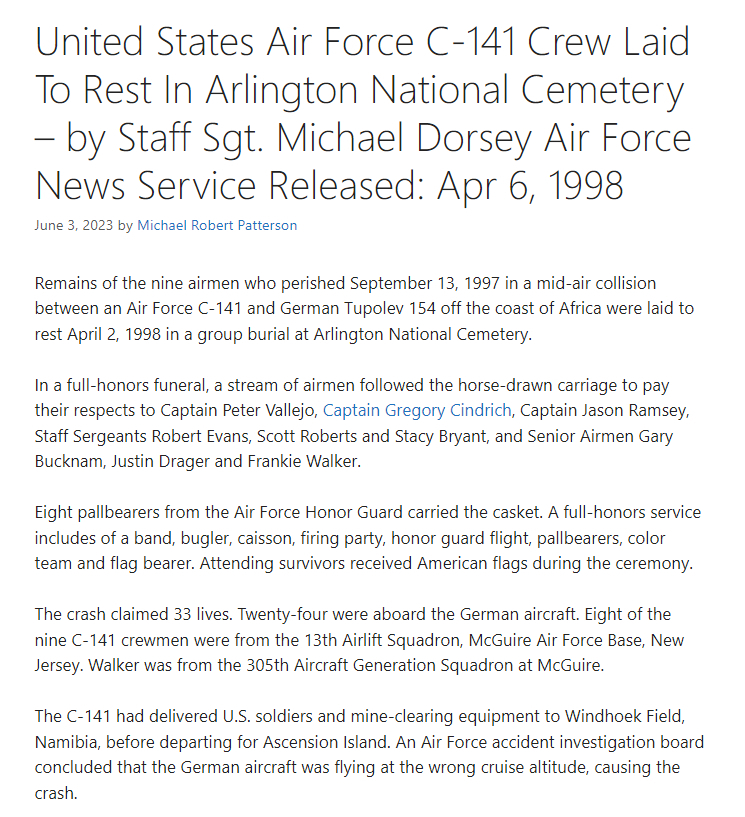


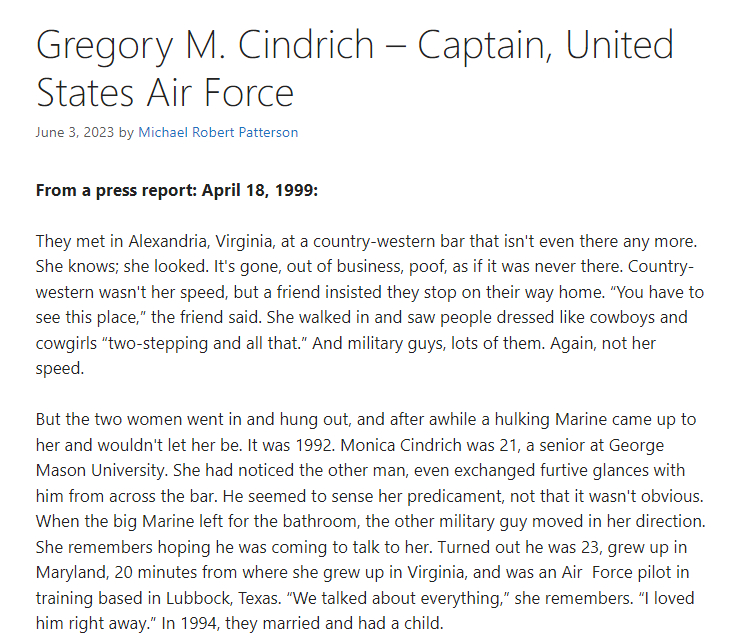
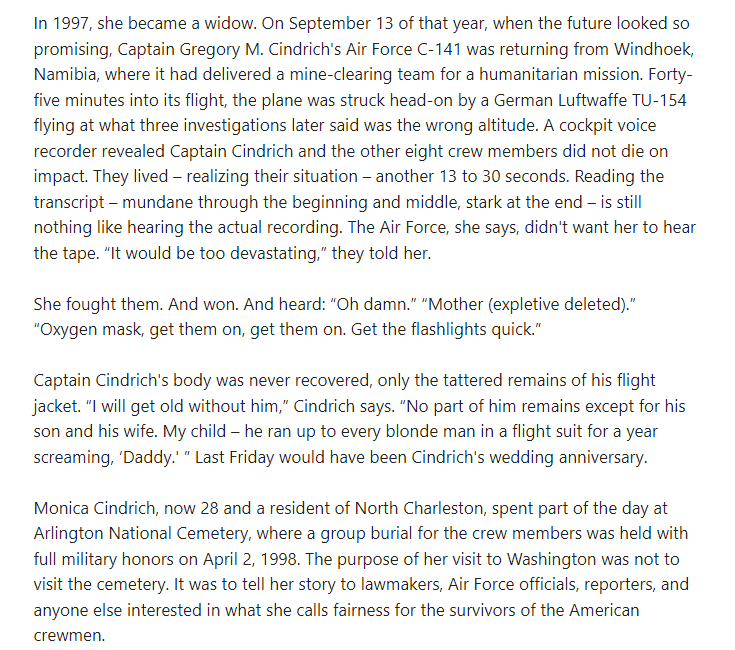




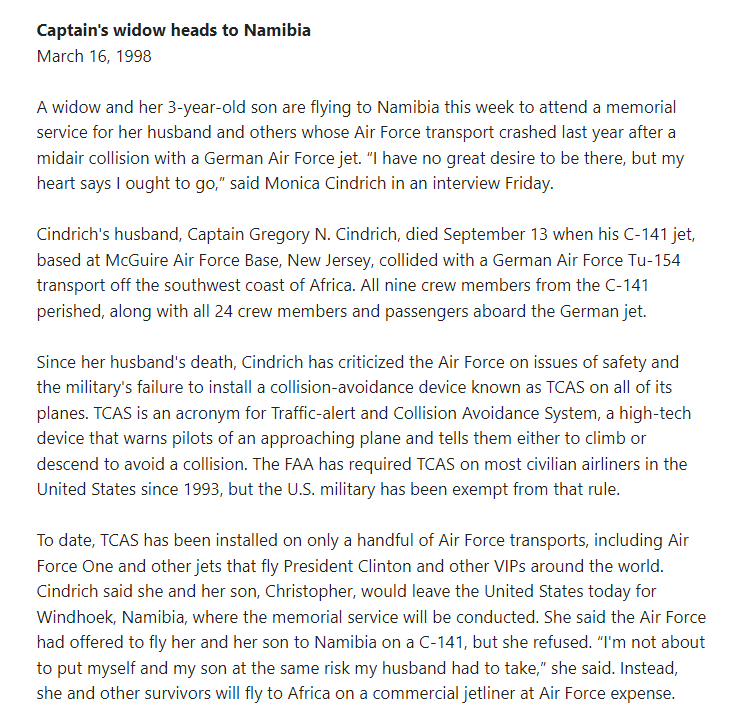

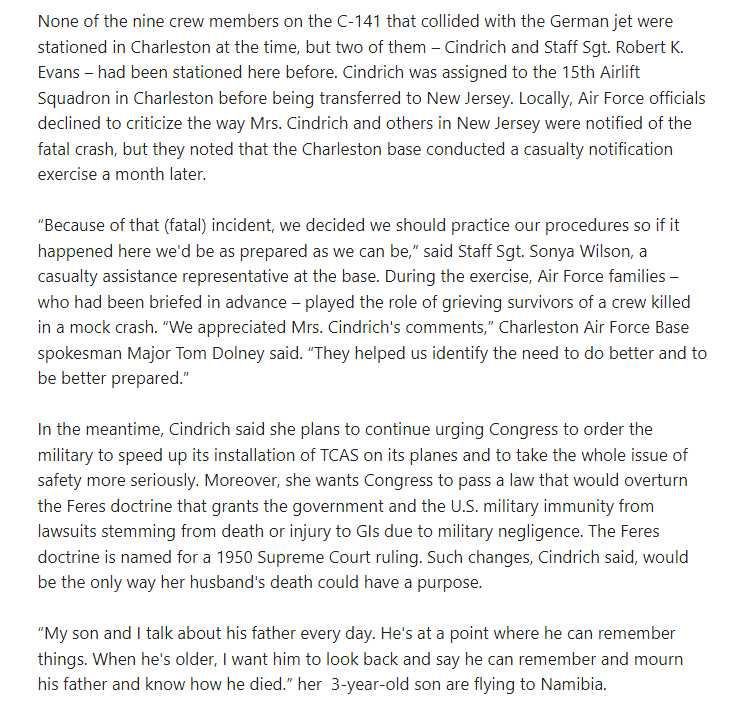
FLIGHT BAN DELAYED FOR AIR FORCE'S BIRTHDAY
By Susanne M. Schafer
AP Military Writer
Posted September 18, 1997
WASHINGTON -- The Air Force celebrates its 50th anniversary today minus its
feisty chief of staff, its civilian leader on her way out the door and many of
its aircraft about to be grounded temporarily because of safety concerns.
Acting in the wake of five military air crashes in four days, Defense Secretary
William Cohen ordered the Air Force and its sister services to halt training
flights for a one-day period over the coming week, beginning early Friday.
That decision allowed the Air Force to go ahead with the fly-overs and other
events scheduled around the globe today, marking the birth of America's youngest
military service. The Department of the Air Force was established when President
Truman signed the National Security Act of 1947 and the Army Air Corps became the
Air Force.
But the anniversary comes as the service has struggled through a rough year.
--The service's No. 2 officer -- Gen. Ralph Eberhart -- is at the helm instead of
Gen. Ronald Fogleman, the outspoken chief of staff who resigned in July. He cited
differences with the Pentagon leadership over placing blame on an Air Force
officer for the 1996 terrorist attack that claimed the lives of 19 airmen at
Khobar Towers in Saudi Arabia.
--Secretary Sheila Widnall, the only female civilian head of a military service,
is leaving next month to return to academia. She has served since the beginning
of Clinton's first term.
--On Wednesday, Cohen ordered all military services to take a 24-hour break in
training flights to review safety procedures. His order followed a series of air
crashes -- among them the spectacular breakup of an Air Force F-117A stealth
fighter at an air show in Maryland and the collision of a German military plane
and an Air Force C-141 flying a humanitarian mission to Africa, killing nine
Americans. And on Tuesday, two Air National Guard F-16s collided Tuesday off New
Jersey, but no one was killed.
Nevertheless, Widnall insisted today: "This is one of our best safety years. ...
But in something like aircraft safety, there is always room for improvement."
She said the stand-down would be "an appropriate time for our units to reflect
on the inherent dangers of flying military aircraft."
This spring, the service dealt with the bizarre case of an A-10 pilot who flew
off course during a training exercise and slammed his plane and its bomb cargo
into a Colorado mountainside. Then the service took a flogging over the removal
of the service's first female B-52 pilot, 1st Lt. Kelly Flinn, for adultery and
disobedience.
That was followed by the demise of one of the service's top stars -- Gen. Joseph
Ralston, who was tapped to become the next chairman of the Joint Chiefs of Staff,
but whose candidacy was derailed after he acknowledged conducting an adulterous
affair years ago.
Too, the Air Force blamed its own commanders and pilot error for the April 3,
1996, crash in Croatia of an Air Force jet -- an accident that claimed Commerce
Secretary Ron Brown and 34 others.
Overall, the service is facing a time when its pilots are fleeing to get
high-paying jobs with the airlines.
The officer nominated to take over from Fogleman, Gen. Michael Ryan, told
senators Tuesday that during the latest round of promotions, 107 captains
notified the promotion board they did not want to be considered for major, so
they could leave the service.
"I have great concern over those numbers," Ryan told the lawmakers.
He's not the only one who's concerned.
"We know that when airlines come hiring, we become the tail on a very big dog,"
Widnall said today on ABC's "Good Morning America." She said the Air Force has
"tried to determine ... the important things to pilots. We're trying to put some
things in place that will make it possible to stay with us. Nobody stays in the
United States Air Force just for the money."
Former Defense Secretary Caspar Weinberger, who was at the Pentagon Wednesday to
sign his latest book, "The Next War," said he believes the Air Force is being
asked to do too much, with too little.
"They are not funded well enough to buy what is necessary for the future. And
their morale is down. I'm very concerned," he said. "But the Air Force is a
great organization. I hope conditions improve."
Earlier this week, Cohen kicked off the service's week of celebrations by saying
that despite the military's difficult times, no one should doubt "that the
future of the Air Force and that of air power is bright and indeed boundless."
Cohen said the service should revere its 50-year history and its air pioneers,
such as Billy Mitchell, Chuck Yeager, Jimmy Doolittle and Hap Arnold. The defense
secretary listed accomplishments the service's 380,000 members should all take
pride in, such as the first flight of its new tactical fighter, the F-22
"Raptor", saying its stealth and advanced avionics "will make it nearly
invincible."
Cohen also lauded the B-2 stealth bomber, the service's satellites, unmanned
aerial vehicles and its work on even more advanced weaponry in the next century.
"The Air Force must continue its move from a brute force to a brain force," he
said.